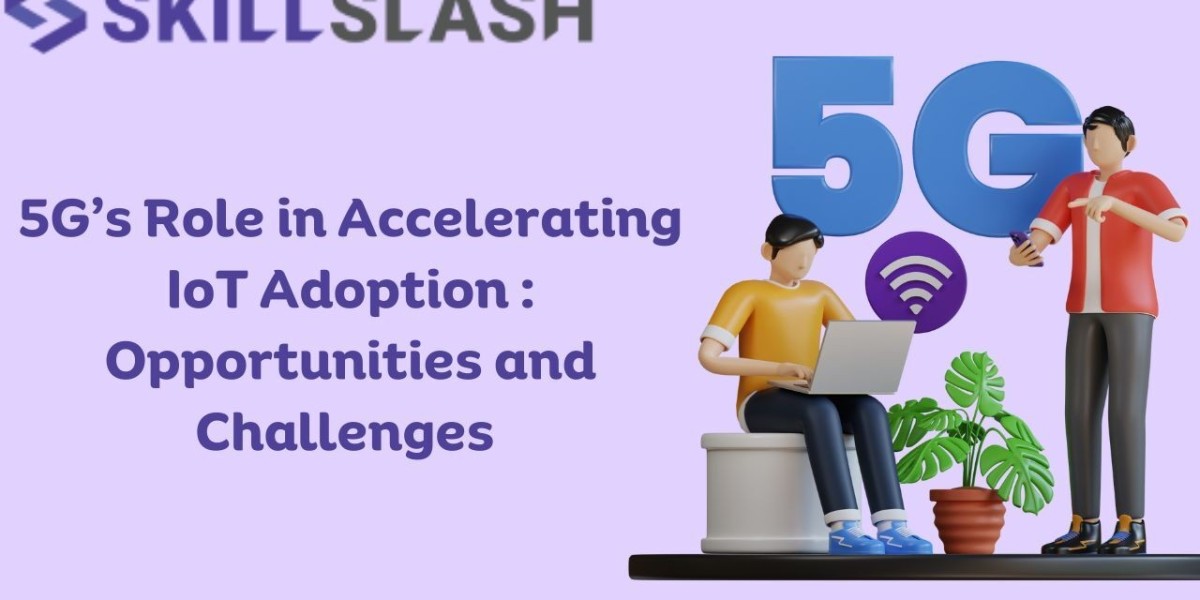The world is undergoing a period of rapid technological transformation due to the combination of two key trends: the expansion of the IoT and the introduction of 5G wireless networks. This combination has the potential to transform industries, improve connectivity, and revolutionize the way we interact and operate.
This article examines the role of 5G in the acceleration of IoT adoption, the opportunities it provides, and the challenges that must be addressed.
The Synergy of 5G and IoT
The Internet of Things (IoT) is a network of physical objects, such as devices, vehicles, and appliances, that communicate with each other over the internet. IoT has been advancing for the past decade, but its full potential has not been fully realized due to the limitations of current wireless networks. The emergence of 5G technology, with its unprecedented speed, low latency, and high device connectivity, is a game-changer that can unlock the full potential of IoT.
The introduction of 5G wireless technology has initiated a new era of communication and connectivity. One of the areas in which 5G is expected to have a major influence is in the field of the Internet of Things. IoT is a network of interconnected devices, sensors, and objects that collect, exchange, and analyze data.
Here’s how 5G accelerates IoT adoption - the opportunities :
1. Enhanced Connectivity :
The introduction of 5G technology has revolutionized the data transmission and communication capabilities of the Internet of Things (IoT) devices, allowing them to send and receive data in real-time and communicate with one another in real-time. This has a significant impact on applications that require immediate response, including autonomous vehicles and other applications that require split-second safety decisions.
5G offers significantly higher data speeds than its predecessors, as well as increased network capacity, allowing IoT devices to communicate with one another at a faster rate than ever before. This is essential for applications that require instantaneous data transmission, including those that require remote surgery and industrial automation.
2. Reduced Latency :
Latency is the amount of time it takes for a request to be received in response to a request. 5G significantly reduces latency, with some networks achieving up to one millisecond of latency reduction. This near instantaneous response is essential for applications such as industrial automation, remote surgery, and other applications where delays could have catastrophic consequences.
5G networks provide near zero latency, allowing for instantaneous communication between Internet of Things (IoT) devices and centralized systems. This is especially important for applications such as smart grids, where fractional decisions can avert power outages or optimize energy consumption.
3. Handling Massive Device Numbers :
Traditional networks do not have the capacity to support tens of thousands of devices at the same time. 5G can support hundreds of thousands of devices in a relatively small footprint. This capacity is a game changer for applications such as smart cities where hundreds of sensors and devices continuously monitor and control everything from traffic flow to waste management.
The widespread adoption of the Internet of Things (IoT) is set to be accelerated by 5G’s capacity to support a significantly higher number of devices in an area. Smart cities will benefit greatly from the proliferation of connected devices that manage traffic, energy consumption, and public services.
4. Energy Efficiency :
Lots of IoT devices are powered by batteries, so they need to run as efficiently as possible to last as long as possible. 5G’s architecture uses energy-saving protocols that let devices talk to each other and send data while using as little energy as possible. This is especially important for IoT devices that are deployed in remote or remote places where it can be hard to replace the battery.
5. Network Slicing :
The introduction of 5G technology necessitates the implementation of network slicing, which involves the division of a single physical network into multiple virtual networks, each of which can be tailored to meet particular requirements. This is of particular importance for the Internet of Things (IoT), as various applications require varying levels of bandwidth and latency.
Network slicing facilitates the efficient allocation of resources to meet these varying requirements, thus increasing reliability and security, which is essential for applications such as remote health monitoring and the management of critical infrastructure.
6. Realizing Complex Use Cases :
The complexity of Internet of Things (IoT) applications is growing day by day. For example, imagine a self-driving vehicle that needs to interact with traffic signals, other vehicles and road infrastructure. All of these interactions require high-speed low-latency connectivity, which only 5G can offer. Without 5G, many of the most advanced IoT applications would remain theoretical or out of reach.
7. New Business Models :
The integration of 5G and the Internet of Things (IoT) provides new opportunities for revenue generation. Businesses can leverage the insights generated from IT devices to provide data-centric services, subscription plans, and premium packages. For instance, a manufacturing facility can optimize its production processes by collecting real-time data from sensors.
8. Improved Data Analytics :
As the amount of data generated by the Internet of Things (IoT) devices continues to grow, the importance of data analytics has never been greater. 5G's high-speed connectivity guarantees timely access to data for analysis, allowing businesses and organizations to make real-time informed decisions.
To sum up, 5G’s role in speeding up IoT adoption is critical. Its improved connectivity, low latency, capacity to support hundreds of millions of devices, power efficiency, and the ability to support complex use cases enables IoT applications that previously seemed impossible. Challenges such as security, interoperability exist but the potential for 5G-powered IoT is immense and can transform industries, increase productivity, and improve our daily lives.
5G’s role in IoT adoption - the challenges :
The combination of 5G and IoT has the potential to revolutionize the way we live, work and play. However, it also brings with it a number of challenges that must be addressed if we want to see widespread adoption and success. These challenges range from technical barriers to regulatory and security issues.
Here are some of the key challenges :
1. Infrastructure Investment :
The implementation of 5G infrastructure necessitates substantial investments in the construction of new cell towers, the installation of small cells, and the upgrading of existing network elements. This challenge is particularly acute in rural and economically disadvantaged regions, where the potential return on investment may not be as significant. To overcome this obstacle, cooperation between governments, telecommunications companies, and other relevant stakeholders is necessary to guarantee widespread coverage.
2. Security Vulnerabilities :
As the number of connected devices increases exponentially, the potential for cyber attacks increases exponentially. Many Internet of Things (IoT) devices have a long history of inadequate security measures, allowing them to be hacked, data compromised, and even used as gateways to larger networks. With the advent of 5G, which enables even more devices to be connected, it is imperative to implement robust security policies and standards to safeguard both end-users and critical infrastructure.
3. Interoperability and Standards :
The Internet of Things (IoT) is made up of lots of different devices from different manufacturers, all running on different protocols and standards. Without interoperability, it can be hard to communicate and exchange data between devices, making it hard to integrate and limiting IoT’s potential. It is important to create and follow standardized protocols to make sure everything works together and runs smoothly across different IoT ecosystems.
4. Regulatory and Spectrum Challenges :
Regulatory barriers to 5G networks have come up in some areas. People are worried about how the spectrum will be used, what it could do to their health, and how it might affect the environment. All of this has led to debates and delays in 5G rollouts. Governments and regulators need to figure out how to keep innovation going while also meeting people’s needs, so that 5G-connected IoT can work without putting safety and people’s health at risk.
5. Data Management and Privacy :
The collection, processing, and analysis of large volumes of data generated by Internet of Things (IoT) devices presents significant challenges. Storage, processing, and bandwidth requirements are particularly challenging to manage, particularly when considering the privacy of users. As the collection of more sensitive and personal data from IoT devices increases, strong data protection and privacy frameworks must be established to protect users’ data from unauthorized access and misuse.
6. Network Congestion :
5G provides a significant increase in data speeds and capacity, however, the sheer number of IoT devices connected at the same time could potentially result in network congestion. In particular, network congestion is a major concern for applications that require extremely low latency, as congested networks can result in delays and performance problems.
7. Skill Gap and Workforce training :
When it comes to deploying, maintaining and managing IoT infrastructure with 5G capabilities, it takes a skilled workforce with experience in both telecoms and IoT. To make sure organizations can make the most of these technologies, it is important to bridge the skills gap through training and education.
8. Environmental Concerns :
There is a lot of buzz around the Internet of Things (IoT) and 5G, but it is important to keep in mind that these technologies can have a negative impact on the environment. For example, they can use up more energy and cause more electronic waste, so it is important to make sure these technologies do not cause too much damage to the environment.
5G and the Internet of Things (IoT) face a number of challenges that need to be addressed in order for 5G and IoT to reach their full potential. These challenges range from technical to regulatory, security and ethical. Governments, industry, academia and the public must work together to develop solutions that address these challenges and create a world where 5G-enabled IoT can operate safely, securely and efficiently.
In Conclusion,
5G and the Internet of Things (IoT) are ushering in a new era for technology, one that promises to transform industries and societies. From smart cities and healthcare innovation to industrial automation and agricultural innovation, the opportunities presented by 5G-IoT are endless. However, the challenges that must be overcome are immense. Overcoming infrastructure challenges, security issues, interoperability issues, regulatory and data-related issues will be key to unlocking the full potential of the 5G-powered IoT. As stakeholders work together to address these issues, the future promises a more connected, more efficient, and more data-driven world.



